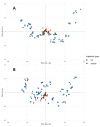Hopomics: Humulus lupulus Brewing Cultivars Classification Based on LC-MS Profiling and Nested Feature Selection
- PMID: 36295846
- PMCID: PMC9609554
- DOI: 10.3390/metabo12100945
Hopomics: Humulus lupulus Brewing Cultivars Classification Based on LC-MS Profiling and Nested Feature Selection
Abstract
Omics approaches in plant analysis find many different applications, from classification to new bioactive compounds discovery. Metabolomics seems to be one of the most informative ways of describing plants' phenotypes, since commonly used methods such as liquid chromatography-mass spectrometry (LC-MS) and nuclear magnetic resonance spectroscopy (NMR) could provide a huge amount of information about samples. However, due to high efficiency, many disadvantages arise with the complexity of the experimental design. In the present work, we demonstrate an untargeted metabolomics pipeline with the example of a Humulus lupulus classification task. LC-MS profiling of brewing cultivars samples was carried out as a starting point. Hierarchical cluster analysis (HCA)-based classification in combination with nested feature selection was provided for sample discrimination and marker compounds discovery. Obtained metabolome-based classification showed an expected difference compared to genetic-based classification data. Nine compounds were found to have the biggest classification power during nested feature selection. Using database search and molecular network construction, five of them were identified as known hops bitter compounds.
Keywords: Humulus lupulus; machine learning; metabolomics; untargeted profiling.
Conflict of interest statement
The authors declare no conflict of interest.
Figures





Similar articles
-
Nuclear magnetic resonance and high-performance liquid chromatography techniques for the characterization of bioactive compounds from Humulus lupulus L. (hop).Anal Bioanal Chem. 2018 Jun;410(15):3521-3531. doi: 10.1007/s00216-018-0851-y. Epub 2018 Jan 19. Anal Bioanal Chem. 2018. PMID: 29350255
-
Sensomics analysis of key bitter compounds in the hard resin of hops (Humulus lupulus L.) and their contribution to the bitter profile of Pilsner-type beer.J Agric Food Chem. 2015 Apr 8;63(13):3402-18. doi: 10.1021/acs.jafc.5b00239. Epub 2015 Mar 27. J Agric Food Chem. 2015. PMID: 25793563
-
Fast Sampling, Analyses and Chemometrics for Plant Breeding: Bitter Acids, Xanthohumol and Terpenes in Lupulin Glands of Hops (Humulus lupulus).Phytochem Anal. 2017 Jan;28(1):50-57. doi: 10.1002/pca.2642. Phytochem Anal. 2017. PMID: 27976466
-
Determination of α- and β-acids in hops by liquid chromatography or electromigration techniques: A critical review.Food Chem. 2022 Dec 15;397:133671. doi: 10.1016/j.foodchem.2022.133671. Epub 2022 Jul 12. Food Chem. 2022. PMID: 35908460 Review.
-
[Research progress of chemical constituents and pharmacological activities in Humulus lupulus].Zhongguo Zhong Yao Za Zhi. 2017 May;42(10):1825-1829. doi: 10.19540/j.cnki.cjcmm.20170224.016. Zhongguo Zhong Yao Za Zhi. 2017. PMID: 29090538 Review. Chinese.
Cited by
-
LC-MS and NMR Based Plant Metabolomics: A Comprehensive Phytochemical Investigation of Symphytum anatolicum.Metabolites. 2023 Oct 4;13(10):1051. doi: 10.3390/metabo13101051. Metabolites. 2023. PMID: 37887376 Free PMC article.
-
Comprehensive Two-Dimensional Gas Chromatography-Mass Spectrometry as a Tool for the Untargeted Study of Hop and Their Metabolites.Metabolites. 2024 Apr 19;14(4):237. doi: 10.3390/metabo14040237. Metabolites. 2024. PMID: 38668365 Free PMC article.
References
-
- Kubeš J. Geography of World Hop Production 1990–2019. J. Am. Soc. Brew. Chem. 2021;80:84–91. doi: 10.1080/03610470.2021.1880754. - DOI
-
- Korpelainen H., Pietiläinen M. Hop (Humulus lupulus L.): Traditional and Present Use, and Future Potential. Econ. Bot. 2021;75:302–322. doi: 10.1007/s12231-021-09528-1. - DOI
-
- Nesvadba V., Charvátová J. New Fine Aroma Varieties of Hops (Humulus lupulus L.) Saaz Brilliant, Saaz Comfort, Saaz Shine and Mimosa. Kvas. Prum. 2020;66:320–330. doi: 10.18832/kp2019.66.320. - DOI
-
- van Simaeys K.R., Féchir M., Gallagher A., Stokholm A., Weaver G., Shellhammer T.H. Examining Chemical and Sensory Differences of New American Aroma Hops Grown in the Willamette Valley, Oregon. J. Am. Soc. Brew. Chem. 2021;79:1–9. doi: 10.1080/03610470.2021.1968271. - DOI
-
- Mongelli A., Rodolfi M., Ganino T., Marieschi M., Dall’Asta C., Bruni R. Italian Hop Germplasm: Characterization of Wild Humulus lupulus L. Genotypes from Northern Italy by Means of Phytochemical, Morphological Traits and Multivariate Data Analysis. Ind. Crops Prod. 2015;70:16–27. doi: 10.1016/j.indcrop.2015.02.036. - DOI
LinkOut - more resources
Full Text Sources

